
The Heinkel He 111 was a German aircraft designed by Siegfried and Walter Günter at Heinkel Flugzeugwerke in 1934. Through development it was described as a "wolf in sheep's clothing". Due to restrictions placed on Germany after the First World War prohibiting bombers, it masqueraded as a civil airliner, although from conception the design was intended to provide the nascent Luftwaffe with a fast medium bomber.
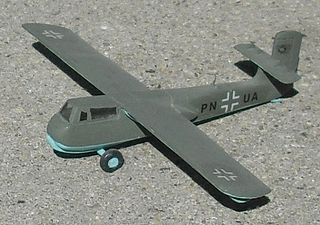
The Blohm & Voss BV 40 was a German glider fighter designed to attack Allied bomber formations during the time of the bombing raids over Nazi Germany.

The DFS 346 was a German rocket-powered swept-wing aircraft which began development during World War II in Germany. It was designed by Felix Kracht at the Deutsche Forschungsanstalt für Segelflug (DFS), the "German Institute for Sailplane Flight". A prototype was constructed but did not reach completion before the end of the war. It was taken to the Soviet Union where it was completed, tested and flown.

Alexander Lippisch's Delta IV was a continuation of his work on delta wing designs pioneered in his Delta I, Delta II and Delta III aircraft.
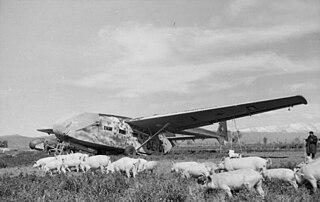
The Gotha Go 242 was a transport glider used by the Luftwaffe during World War II. It was an upgrade over the DFS 230 in both cargo/troop capacity and flight characteristics. Though it saw limited action, it appeared in multiple variants.
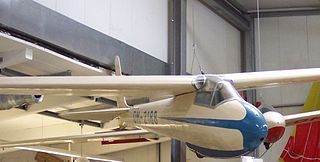
The DFS Olympia Meise was a German sailplane designed by the Deutsche Forschungsanstalt für Segelflug (DFS) for Olympic competition, based on the DFS Meise.

The General Aircraft GAL.48 Hotspur was a military glider designed and built by the British company General Aircraft Ltd during World War II. When the British airborne establishment was formed in 1940 by order of Prime Minister Winston Churchill, it was decided that gliders would be used to transport airborne troops into battle. General Aircraft Ltd were given a contract by the Ministry of Aircraft Production in June 1940 to design and produce an initial glider for use by the airborne establishment, which resulted in the Hotspur.

The Slingsby Hengist was a British military glider designed and built by Slingsby Sailplanes Ltd. Like other British troop carrying gliders in the Second World War, it was named after military figures whose name began with H, in this case the Jute invader Hengist.

The Gribovsky G-11 was a Soviet light troop/cargo military glider of World War II.

The Antonov A-7 was a Soviet light troop military glider of World War II.
The Maeda Ku-1, long designation Maeda Army Type 2 Small Glider, was a small twin boom Japanese military glider. It was primarily used for training, and was superseded by the Kokusai Ku-7, which was effectively a scaled-up version of the design. Approximately 100 were produced.

The Gotha Ka 430 was a military transport glider, first built in 1944. The glider was designed by Albert Kalkert. Twelve had been produced by the end of World War II, but none of them was used operationally.
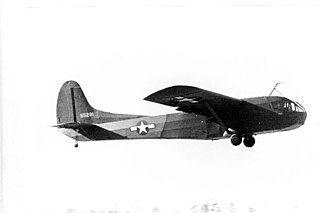
The Waco CG-15 was an American military glider, which was developed from the CG-4. Although outwardly similar to its predecessor and carrying the same number of passengers, a number of changes in the design, including shortened wings and a more streamlined nose enabled it to travel faster. 1,000 were ordered and 473 were delivered before production ceased. Two were transferred to the Navy for testing as the XLR2W-1. One unit was converted into an XPG-3 powered glider which used two Jacobs R-755-9 radial engines.

The DFS 331 was a transport glider prototype developed in a collaboration between DFS and Gotha. It was a twenty-seat troop transport designed by Hans Jacobs, who had previously produced the successful, nine seat DFS 230.
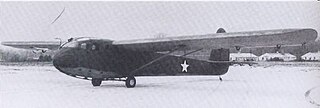
The Waco CG-3A was a US light troop military glider of World War II.

The Gotha Go 345 was a prototype German Military transport glider of the Second World War. A single example was tested in 1944.

The Waco CG-13 was an American military transport glider aircraft developed during World War II.

The Ilyushin Il-32 was a Soviet heavy military glider developed after World War II to deliver 7,000 kg (15,000 lb) of cargo. To facilitate loading and unloading, the glider's nose and tail sections were hinged to swing sideways. The Il-32 required a four-engined aircraft to tow it safely; it was canceled when it became clear that no such tug was going to be available after the Tupolev Tu-75 and Ilyushin Il-18 programs were both canceled because of shortages of their intended Shvetsov ASh-73 engines.

The Focke-Achgelis Fa 225 was an experimental single-seat rotary wing glider built in Nazi Germany by Focke-Achgelis in 1942. Only a single example was constructed.




























